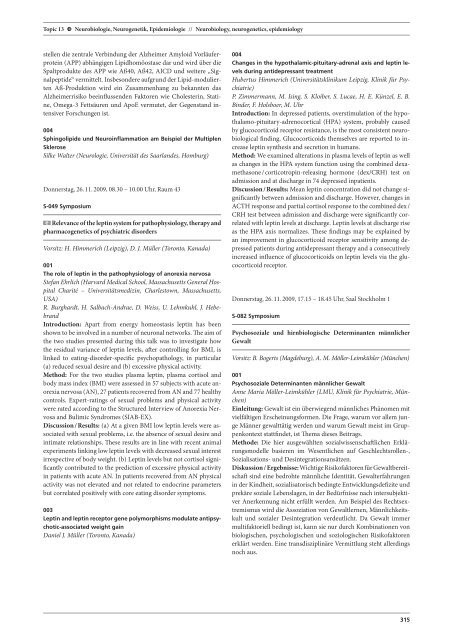Psychische Erkrankungen in der Lebensspanne ... - DGPPN
Psychische Erkrankungen in der Lebensspanne ... - DGPPN
Psychische Erkrankungen in der Lebensspanne ... - DGPPN
Erfolgreiche ePaper selbst erstellen
Machen Sie aus Ihren PDF Publikationen ein blätterbares Flipbook mit unserer einzigartigen Google optimierten e-Paper Software.
Topic 13 G Neurobiologie, Neurogenetik, Epidemiologie // Neurobiology, neurogenetics, epidemiology<br />
stellen die zentrale Verb<strong>in</strong>dung <strong>der</strong> Alzheimer Amyloid Vorläuferprote<strong>in</strong><br />
(APP) abhängigen Lipidhomöostase dar und wird über die<br />
Spaltprodukte des APP wie Aß40, Aß42, AICD und weitere „Signalpeptide“<br />
vermittelt. Insbeson<strong>der</strong>e aufgrund <strong>der</strong> Lipid-modulierten<br />
Aß-Produktion wird e<strong>in</strong> Zusammenhang zu bekannten das<br />
Alzheimerrisiko bee<strong>in</strong>flussenden Faktoren wie Cholester<strong>in</strong>, Stat<strong>in</strong>e,<br />
Omega-3 Fettsäuren und ApoE vermutet, <strong>der</strong> Gegenstand <strong>in</strong>tensiver<br />
Forschungen ist.<br />
004<br />
Sph<strong>in</strong>golipide und Neuro<strong>in</strong>flammation am Beispiel <strong>der</strong> Multiplen<br />
Sklerose<br />
Silke Walter (Neurologie, Universität des Saarlandes, Homburg)<br />
Donnerstag, 26. 11. 2009, 08.30 – 10.00 Uhr, Raum 43<br />
S-049 Symposium<br />
Relevance of the lept<strong>in</strong> system for pathophysiology, therapy and<br />
pharmacogenetics of psychiatric disor<strong>der</strong>s<br />
Vorsitz: H. Himmerich (Leipzig), D. J. Müller (Toronto, Kanada)<br />
001<br />
The role of lept<strong>in</strong> <strong>in</strong> the pathophysiology of anorexia nervosa<br />
Stefan Ehrlich (Harvard Medical School, Massachusetts General Hospital<br />
Charité – Universitätsmediz<strong>in</strong>, Charlestown, Massachusetts,<br />
USA)<br />
R. Burghardt, H. Salbach-Andrae, D. Weiss, U. Lehmkuhl, J. Hebebrand<br />
Introduction: Apart from energy homeostasis lept<strong>in</strong> has been<br />
shown to be <strong>in</strong>volved <strong>in</strong> a number of neuronal networks. The aim of<br />
the two studies presented dur<strong>in</strong>g this talk was to <strong>in</strong>vestigate how<br />
the residual variance of lept<strong>in</strong> levels, after controll<strong>in</strong>g for BMI, is<br />
l<strong>in</strong>ked to eat<strong>in</strong>g-disor<strong>der</strong>-specific psychopathology, <strong>in</strong> particular<br />
(a) reduced sexual desire and (b) excessive physical activity.<br />
Method: For the two studies plasma lept<strong>in</strong>, plasma cortisol and<br />
body mass <strong>in</strong>dex (BMI) were assessed <strong>in</strong> 57 subjects with acute anorexia<br />
nervosa (AN), 27 patients recovered from AN and 77 healthy<br />
controls. Expert-rat<strong>in</strong>gs of sexual problems and physical activity<br />
were rated accord<strong>in</strong>g to the Structured Interview of Anorexia Nervosa<br />
and Bulimic Syndromes (SIAB-EX).<br />
Discussion / Results: (a) At a given BMI low lept<strong>in</strong> levels were associated<br />
with sexual problems, i.e. the absence of sexual desire and<br />
<strong>in</strong>timate relationships. These results are <strong>in</strong> l<strong>in</strong>e with recent animal<br />
experiments l<strong>in</strong>k<strong>in</strong>g low lept<strong>in</strong> levels with decreased sexual <strong>in</strong>terest<br />
irrespective of body weight. (b) Lept<strong>in</strong> levels but not cortisol significantly<br />
contributed to the prediction of excessive physical activity<br />
<strong>in</strong> patients with acute AN. In patients recovered from AN physical<br />
activity was not elevated and not related to endocr<strong>in</strong>e parameters<br />
but correlated positively with core eat<strong>in</strong>g disor<strong>der</strong> symptoms.<br />
003<br />
Lept<strong>in</strong> and lept<strong>in</strong> receptor gene polymorphisms modulate antipsychotic-associated<br />
weight ga<strong>in</strong><br />
Daniel J. Müller (Toronto, Kanada)<br />
004<br />
Changes <strong>in</strong> the hypothalamic-pituitary-adrenal axis and lept<strong>in</strong> levels<br />
dur<strong>in</strong>g antidepressant treatment<br />
Hubertus Himmerich (Universitätskl<strong>in</strong>ikum Leipzig, Kl<strong>in</strong>ik für Psychiatrie)<br />
P. Zimmermann, M. Is<strong>in</strong>g, S. Kloiber, S. Lucae, H. E. Künzel, E. B.<br />
B<strong>in</strong><strong>der</strong>, F. Holsboer, M. Uhr<br />
Introduction: In depressed patients, overstimulation of the hypothalamo-pituitary-adrenocortical<br />
(HPA) system, probably caused<br />
by glucocorticoid receptor resistance, is the most consistent neurobiological<br />
f<strong>in</strong>d<strong>in</strong>g. Glucocorticoids themselves are reported to <strong>in</strong>crease<br />
lept<strong>in</strong> synthesis and secretion <strong>in</strong> humans.<br />
Method: We exam<strong>in</strong>ed alterations <strong>in</strong> plasma levels of lept<strong>in</strong> as well<br />
as changes <strong>in</strong> the HPA system function us<strong>in</strong>g the comb<strong>in</strong>ed dexamethasone<br />
/ corticotrop<strong>in</strong>-releas<strong>in</strong>g hormone (dex/CRH) test on<br />
admission and at discharge <strong>in</strong> 74 depressed <strong>in</strong>patients.<br />
Discussion / Results: Mean lept<strong>in</strong> concentration did not change significantly<br />
between admission and discharge. However, changes <strong>in</strong><br />
ACTH response and partial cortisol response to the comb<strong>in</strong>ed dex /<br />
CRH test between admission and discharge were significantly correlated<br />
with lept<strong>in</strong> levels at discharge. Lept<strong>in</strong> levels at discharge rise<br />
as the HPA axis normalizes. These f<strong>in</strong>d<strong>in</strong>gs may be expla<strong>in</strong>ed by<br />
an improvement <strong>in</strong> glucocorticoid receptor sensitivity among depressed<br />
patients dur<strong>in</strong>g antidepressant therapy and a consecutively<br />
<strong>in</strong>creased <strong>in</strong>fluence of glucocorticoids on lept<strong>in</strong> levels via the glucocorticoid<br />
receptor.<br />
Donnerstag, 26. 11. 2009, 17.15 – 18.45 Uhr, Saal Stockholm 1<br />
S-082 Symposium<br />
Psychosoziale und hirnbiologische Determ<strong>in</strong>anten männlicher<br />
Gewalt<br />
Vorsitz: B. Bogerts (Magdeburg), A. M. Möller-Leimkühler (München)<br />
001<br />
Psychosoziale Determ<strong>in</strong>anten männlicher Gewalt<br />
Anne Maria Möller-Leimkühler (LMU, Kl<strong>in</strong>ik für Psychiatrie, München)<br />
E<strong>in</strong>leitung: Gewalt ist e<strong>in</strong> überwiegend männliches Phänomen mit<br />
vielfältigen Ersche<strong>in</strong>ungsformen. Die Frage, warum vor allem junge<br />
Männer gewalttätig werden und warum Gewalt meist im Gruppenkontext<br />
stattf<strong>in</strong>det, ist Thema dieses Beitrags.<br />
Methode: Die hier ausgewählten sozialwissenschaftlichen Erklärungsmodelle<br />
basieren im Wesentlichen auf Geschlechtsrollen-,<br />
Sozialisations- und Des<strong>in</strong>tegrationsansätzen.<br />
Diskussion / Ergebnisse: Wichtige Risikofaktoren für Gewaltbereitschaft<br />
s<strong>in</strong>d e<strong>in</strong>e bedrohte männliche Identität, Gewalterfahrungen<br />
<strong>in</strong> <strong>der</strong> K<strong>in</strong>dheit, sozialisatorisch bed<strong>in</strong>gte Entwicklungsdefizite und<br />
prekäre soziale Lebenslagen, <strong>in</strong> <strong>der</strong> Bedürfnisse nach <strong>in</strong>tersubjektiver<br />
Anerkennung nicht erfüllt werden. Am Beispiel des Rechtsextremismus<br />
wird die Assoziation von Gewaltlernen, Männlichkeitskult<br />
und sozialer Des<strong>in</strong>tegration verdeutlicht. Da Gewalt immer<br />
multifaktoriell bed<strong>in</strong>gt ist, kann sie nur durch Komb<strong>in</strong>ationen von<br />
biologischen, psychologischen und soziologischen Risikofaktoren<br />
erklärt werden. E<strong>in</strong>e transdiszipl<strong>in</strong>äre Vermittlung steht allerd<strong>in</strong>gs<br />
noch aus.<br />
315


